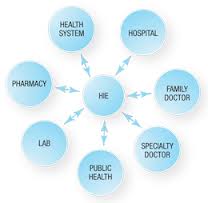 The Role of HIE in Clinical Analytics
The Role of HIE in Clinical Analytics
Rodney Hamilton, MD, CMIO, ICA
Read part 1 of this series
Read part 2 of this series
In his rumination about HIMSS12, John Moore also likened the current buzz in clinical analytics to a similar buzz a few years earlier about HIE, when that market was first emerging and bursting at the seams with excitement and promise. Turns out the two may go hand-in-hand and in fact both bolster the effects of the other.
As stated, the problem now isn’t a dearth of clinical data. The problem is rapidly becoming too much data housed in various and “disparate” storage systems in different formats that are difficult to access and often impossible to align in a usable way for physicians treating patients. Hence the phrase: “messy data.” Many of the elements of HIE have been built to address this quandary. It’s one thing to pull and aggregate usable structured data from rational systems. It’s another to access combinations of non-structured and discrete data from non-friendly systems with conflicting information and be able to interpret that data in real-time while treating a patient individually, or at a population level, to make broader management decisions.
HIEs now have the ability, through laying down a foundation of interoperability, of accessing, aggregating and exchanging clinical data via the standards-based exchange of continuity of care documents (CCDs) between electronic health records. Through technology that utilizes integration standards, such as Direct, IHE, HL7, and others, clinicians are able to access exchanged data directly through their EHRs. By aggregating and “normalizing” both the HL7 and CCD content made available to the HIE, the content can be organized and stored in a clinical data repository (CDR). The CDR can then be accessed by other sources such as clinical analytics applications, care management tools, personal health records, alerting and notification applications, etc.
These capabilities and tools form the basis for the access, synthesis and use of structured and unstructured data that will take the exchange of clinical information to the next level.
The Lines Begin to Blur
As such, clinical vendors, even niche vendors, while continuing to expand their HIE and analytics offerings to meet these emerging demands, are finding greater emphasis being placed on population health capabilities and tools that help non-affiliated organizations exchange and analyze both discrete and unstructured information: the line between HIE and clinical analytics is rapidly blurring. These tools must work together to identify, source, translate and analyze the available data.
Hospitals will increasingly require both sets of tools as the exchange of clinical information becomes more ubiquitous, and the demand for accountability becomes more dominant. “Given the demand for greater accountability, delivery organizations will need to use information and data from an increasingly broad community of care partners to help reduce costs and manage quality and outcomes. Hospitals and health systems will need to exchange data with non-affiliated organizations – and actually use that data to influence care decisions. Providers will need to be alerted to gaps in care such as overdue tests and procedures, and it will be just as important to understand what services have already been provided so as to avoid duplication. Simply aggregating patient data from disparate systems across multiple settings of care will not be sufficient; organizations will also need robust analytics tools that can spot trends across a defined population, identify high risk patients, and gauge performance on required metrics.”[1]
The common ground of HIE and clinical analytics are data aggregation and storage, normalization, and workflow support and integration, all from a universe of capabilities that drive connectivity, messaging, population health management, predictive analytics and decision support. The blending of HIE and analytics is the inevitable next step on the path toward the seamless exchange of clinical information drawn from often rival organizations using different systems that may house unaligned, incorrect and generally messy data. The power of these technologies together provides a solution that can extract, translate and synthesize that data to turn it into usable clinical information giving physicians and providers the information they need when they need it to improve patient outcomes and reduce costs. [2]
[1] Jason D. Fortin, “The Imperative for Robust HIE and Analytics Tools”, Healthcare Informatics, September 5, 2012
[2] Jason D. Fortin, “The Imperative for Robust HIE and Analytics Tools”, Healthcare Informatics, September 5, 2012
Rodney Hamilton, MD is the Chief Medical Information Officer at ICA. This blog post was first published on ICA’s HITme Blog.
